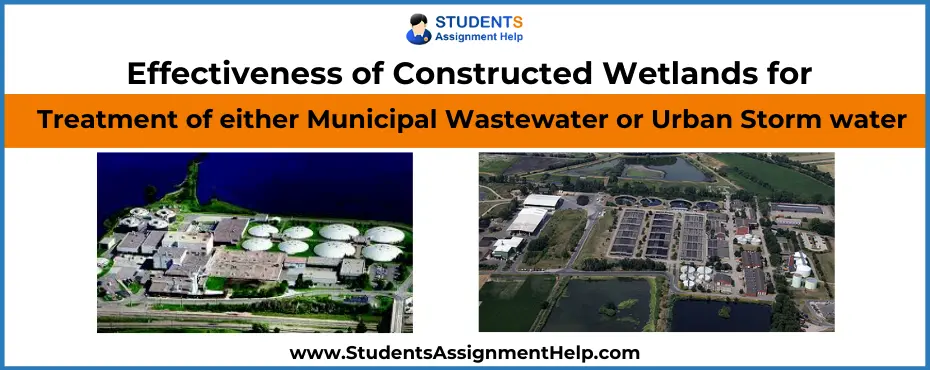Review the Effectiveness of Constructed Wetlands for the Treatment of either Municipal Wastewater or Urban Storm water

Assignment Question: Assessment Item 2
CONDITIONS AND ASSESSMENT CRITERIA FOR LITERATURE REVIEW
The review should present an up-to-date account of the topic, and requires a synthesised overview of the assigned topic and presentation of an accurate reference list. Failure to adequately reference all written text is plagiarism. See Guidelines and Your review should demonstrate: adequate coverage of literature; analysis of current status of the treatment wetlands; use of suitable examples/case studies; logical thought and sequencing of content; and critical evaluation.
Flexible Rates Compatible With Everyone’s Budget
Hire a Professional Essay & Assignment Writer for completing your Academic Assessments
You should use the following major headings but sub-headings should also be used at your:
1. Introduction/Background:- this should introduce your topic and provide relevant background information, definitions. Explain the relevance of the topic.
2. Performance Effectiveness in Contaminant Removal:- demonstrate adequate coverage of literature, analysis of performance efficiency, use of suitable examples/case studies, logical thought and sequencing of content, critical evaluation.
3. Strengths and Weaknesses:- demonstrate adequate coverage of literature, analysis of current status of the problem, use of suitable examples/case studies, logical thought and sequencing of content, critical evaluation.
4. Conclusion/Recommendations:- summary of major outcomes and any management recommendations. Include summary table of Strengths and Weaknesses.
5. References:- accurate presentation of reference list, adequacy of referencing of points covered in review. Use Harvard system.
Review the Effectiveness of Constructed Wetlands for the Treatment of either Municipal Wastewater.
Introduction/Background: Effectiveness of Constructed Wetlands
Constructed wetlands are considered as the system or process that is designed by manpower for the proper treatment of wastewater. Through constructed wetlands, the wastewater is removed with the help of the natural process. These natural processes help in maintaining and controlling the efficiency of the wetlands (Wetlands international, 2003.).The flow of constructed wetlands is designed ion to two forms that are horizontal flow and vertical flow. Constructed wetlands are specially designed in order to treat the problems that are generated due to waste wastewater.
These wetlands help in removing the dangerous sediments and infected materials from the water. Constructed wetlands are mostly used in places where the soil is not suitable for the disposal of the waste material. These wetlands can also be used in those places where the soil of the ground is highly saturated (Wetlands international, 2003.). Constructed wastewater are planned and designed for delivering proper treatment to the municipal wastewater. In order to provide a healthy environment to all, the constructed wetland emerges as a valuable concept for providing and delivering safe wildlife to all. These wetlands help in improving the quality of water and also help in increasing the effectiveness of resources (DIANE Publishing. 2012). Constructed wetlands help in keeping the water free from the affluent and have great efforts for enhancing the quality of river water.
Bogs and marshes are some natural wetlands that helped in maintaining and promoting the quality of food and water. This system of wetland was found to be quite effective as it helped in delivering many benefits to the public due to which the use of wetlands has increased for treating with municipal waste water (United States Environmental Protection Agency, 2004).
Buy high-quality essays & assignment writing as per particular university, high school or college by UK, USA & Australian Writers
In the past few decades, the importance and use of the wetlands have understood by many studies. On the basis of which, many systems were designed and implemented successfully for the purpose of meeting the objective of delivering fresh and healthy water. These wetlands were proved to be effective in terms of improving the quality of water without creating any harm for wildlife.
Furthermore, in order to deliver some more benefits to the wildlife, constructed wetlands were designed and implicated for the purpose of effective utilization of the natural wetlands (United States Environmental Protection Agency, 2004). As these systems help in enhancing the quality of water by removing polluted substances from it so in order to introduce multiple functions, scientists have introduced constructed wetlands. Constructed wetlands act as treatment system that involve the use of some natural processes like vegetation of wetland, soil etc. for enhancing the quality of municipal waste water (Waste water gardens, n.d.).
Constructed wetlands help in the decomposition of the micro organisms which help in removing the biodegradable substances from the soil. This would further help in maintaining the fertility of the soil. In removing all the biodegradable substances from the soil, aquatic plants also play a very essential role (Wetlands international, 2003.). The main benefit that arises due to the use of constructed wetlands is that it helps in delivering the habitat wildlife, which is considered as the main benefit inn making the environment free from pollution (EPA.gov, 2000.).
Performance Effectiveness in Contaminant Removal for Effectiveness of Constructed Wetlands
Suspended solids are the materials that contain both organic and inorganic substances. This type of solid material are generally found in the waste water from sanitary and industries. The other sources where suspended solids can be found are erosion of soil from the agricultural lands and the under construction sites (North Dakota department of health, 2005.). As the level of suspended solids increases in the water, the quality of water gets decreases. The capacity of the water to support the marine life gets reduced as the temperature of the water gets high.
To remove the contaminant suspended solids from the water, the technique of constructed wetland is used. Constructed wetland is of two types and which type of wetland should be adopted for the removal of suspended solids is based on the nature of the waste and the location of the site. Constructed wetlands include different mechanisms which are effective in removing the suspended solids (Ecoteam, n.d.).
Among all the mechanisms, the best mechanism which can be used to remove the suspended solids is sedimentation. Along with this, the method of filtration or interception is also used to remove the suspended solid at the secondary level.
These methods vary depending on the size of the particle, shape and structure, level of gravity and the property of the fluid which is present in the suspended solid. This method has proved to very effective as it helped in reducing the level of suspended solids in the water and makes the water suitable to support the aquatic life (Norton, n.d.).The constructed wetland is an effective manner as it is very cost effective and helps in controlling the level of the pollution. In addition, this method is the best way to treat the water and to remove the contaminants from the water which originates from various specific and non specific sources.
This wastewater treatment system can be applied to treat the waste water originating from the sources like industries, dairy firms, pulp mills and etc (United Nations environment programme, n.d.). The effectiveness of the constructed wetlands depends on the two factors; hydrology and topography. Hydrology means that the area of the constructed wetlands should have sufficient amount of water all around the year. This factor will help the constructed wetlands in treating the water in an effective manner. The other factor which is known as topography means that the constructed wetland system should not affect the natural eco system like lakes, rivers and reservoirs (United Nations environment programme, n.d).
If you need help with any assignment like this sample related to any Geography Assignment Help, then you can ask from the experts from StudentsAssignmentHelp.com.
This system is very effective but it is also important to ensure that the same system should not become the source of any kind of contaminant which can affect the quality of the water. This system is also effective as it is capable of treating the water from any sources and also do not harm the ecology. This system consists of the designed processes and principles which uses the plants, sunlight, microbes and gravity to treat the water and make it usable for the effective cultivation process and to improve the marine life. This method is more effective to the developing countries as it uses the concept of biomass and the focuses on the aquaculture.
The constructed wetland system helps in removing the suspended solids by about 98 percent. In addition, the technology used by the constructed wetland system is fully tested (Wastewater Gardens, n.d.). It has also been analysed in various researches that this system helps in improving the quality of the water and also provide different benefits. The benefits also include the development of proper habitat for the animals and to make the food available for them as well.
This system is also effective because the structure of the system did not get affected minimum for 15 years. This is a system that requires a low cost for implementation and also it does not require investing any extra cost for its management. The establishment of this system does not require any extra space (Wastewater Gardens, n.d.).
The constructed wetland system is the best method for removing the suspended solids from the water. In this context the effectiveness of the constructed wetland can also be sighted by using some examples or incidents. The first incident is related to a river of Southern Taiwan which is known as The Erh-Ren River. This river is the most contaminated river in the Taiwan.
To make the water suitable for the marine life, a system was constructed which is known as The Erh-Ren River Constructed Wetland system (ERRCW). This system consists of free surface flow wetland (FSF) and subsurface flow wetland (SSF). This system was inclusive of macrophytes that helped in the effective removal of suspended solids (Jing, S.R. et al, n.d.). The results derived after the implementation of this system was effective and noticeable.
The results also showed that this system has controlled the growth of algae which is a factor for improper removal of the suspended solids. This system has also proved to be effective as it allows the filtration of solids by setting obstacles and also enables the water to supply more oxygen.
The cities like Denmark, Germany, Britain and many more are using the system of constructed wetlands to remove the contaminants from the water. In the same manner, Bielkowo has also adopted this system to remove the suspended solids to improve the conditions of the aquatic life. This system was adopted to remove the harmful particles from the water which flow through the rural areas (Obarska-Pempkowiak, Ozimek, and Haustein, 2002.).
To attain the effective result, the membrane filters were used which helped in measuring the amount of suspended solids in the water. This method has proved to be very effective for purifying the water of hydrophyte pond which is in Bielkowo as it reduced the level of suspended solids by 83 perfect which is a very high amount. In the previous years, new improvements had been undertaken to remove the contaminants from the water which was approximately 300 per year but these were not successful in providing the desired results. The constructed wetland method has helped in achieving the result in an effective manner and is removed the suspended solids from the water at a very good speed. In addition, this is a cost effective manner which helped in developing the economy of the city. In addition, this method has also helped in developing a better ecosystem in Poland.
Similarly, the constructed wetlands system has also proved to be effective in Ireland. The same system had undergone a noticeable change and advancement in the last decade because of its effectiveness in Ireland. This method had adopted by Ireland to remove the suspended solids from the waste water of a private dairy farm which was in Co. Sligo. In Ireland, this system had worked effectively as it is a very low cost system and it offers the best treatment of the waste water.
After this, the same system was applied was applied in the different parts of the country and in five years, the country had approximately 150 constructed wastelands sites (Babatunde, et al, 2008). The government of Ireland had decided to invest on this system as it had proved to be very helpful to the local civilians and to the farmers as well. In addition, this system was helpful in controlling the level of the pollution and maintaining the proper eco system. In Ireland, this system has removed the suspended solids at a very high percentage which ranges from 77.4 percent to 86.2 percent.
Strengths/weaknesses of Constructed wetlands in the context of suspended solids:
These technologies which are used in the treatment of municipal waste water are increasing with a fast rate in all over the world. As the number of industries, factories are increasing with the fast rate so the problem of waste water is also increasing in the cities (Heathcote, n.d.).Many industries have started using the constructed wetlands as an alternative for removing the problem of waste water. From the past years, this problem has resolved to a great extent. Various community systems are developed for the purpose of providing proper treatment system which is considered as the important concept that would help in avoiding all the expensive, large drainage treatment methods.
STRENGTHS
a.) The constructed wetlands are proved to be useful for the treatment of greywater, faecal sludge along with the post treatment of black water after anaerobic treatment. The presence of constructed wetlands creates aerobic conditions for the plants and induces the growth of autotrophic and heterotrophic bacteria. The same strength of constructed wetland can be explained with the example of Milan Army Ammunition Plant at Milan, Tennessee. The plant used the system of constructed wetland to remove the explosive wastes from the ground water.
The construction of subsurface wetland has proved to be effective for the Ammunition Plant in treating the water effectively and make it usable (Lorion, 2001). In addition, this system had proved to cost effective system for treating the water and removing the explosive wastes.
b.) In comparison to natural wetlands, the constructed wetland is featured with flexibility of site location (Kröpfelová, 2008). Moreover, constructed wetlands increase the scope of surface availability for the growth of micro organism bio film.
Stuck with a lot of homework assignments and feeling stressed ?
Take professional academic assistance & Get 100% Plagiarism free papers
c.) The operational, as well as maintenance functions of the constructed wetlands, are comparatively simple and effortless in nature (Kröpfelová, 2008). This method of economic engineering is eligible of providing a reliable as well as inexpensive way of treating variety of wastewaters and has been proved to be the most suitable for polishing and advanced treatment if the reuse of water is possibly an option (environmental protection government agency, n.d).
d.) The constructed wetlands are easily convertible and integrated into landscaping accompanied with the landscape enhancement in the context of texture, color and the plant material. A great amount of tolerance level in the context of waste water loading in varied amount provided they are properly design and architected (Vymazal, 2008). This feature of constructed wetlands is a significant in nature in the context of varying livestock production level, varies climatic conditions and other managerial modifications.
The above stated strength can also be explained by using an example which is related to the Perdido Municipal in Florida. In Perdido, the system of constructed wetland was adopted to treat the landfill leachate. This system had helped in reducing the level of suspended solids by 98 percent (Lorion, 2001). The constructed wetland is capable of treating all kinds of wastes regardless of its structure, shape and size. This system has proved to be effective method for treating the landfill leachate.
e.) During the treatment of animal wastewater, odour in the water proves to be a serious problem specifically in the circumstances wherein, farming operations are closely located to residential area. Under such cases, constructed wetlands prove to be helpful in completely eliminating the odor (Vymazal, 2008). Constructed wetlands are also proved to helpful in enhancing wildlife as it can add to the attractiveness and usefulness of the area.
f.) The design of constructed wetlands is site specific in nature as the topography; soil types, livestock operations, water supply etc are considered before the selection of the site (Wetlands for wastewater treatment, n.d.). Hence, these specifications related to the accommodation of constructed wetland lead to lesser expensive affair.
WEAKNESSES
a.) Since, the constructed wetlands are constructed in systems which lead to free water surface, they attract a lot of mosquitoes and other insects leading to transmission of pathogens and nuisance pests such as malaria and arbo viruses (Wetlands for wastewater treatment, n.d.).
b.) There is numerous start-up problems involved in the gestation period of constructed wetlands. The problems are inclusive of project phasing of clusters along with the construction sequencing of clusters individually (Wetlands for wastewater treatment, n.d.). The specific problems which are uniquely related to wetland construction are inclusive of pipe installation, baffle installation, media placement etc.
c.) The constructed wetlands can only be set up in a wide and open area and the designs of constructed wetlands are in empirical form (Vymazal, 2008). If they get filled in with the flow pattern or solid pattern, they can prove to be seriously disruptive when there design discontinues allowing the removal of solids immediately before the entry of waste water into the constructed wetland.
Conclusion and Recommendations:
As per the above context, it is clear that the construction of wetland proves to be very effective as it reduce the loads on the output and improves the quality of water. It has also proved effective for the well doing water treatment of waste removal and animal wastewater. On the basis of the above discussion, it is concluded that the constructed wetland is the very efficient method for removing unwanted substances from the water like metal substance etc. This method of making the water free from pollution is less expensive and can be easily implemented in comparison of the other water treatment technologies.
For proper wetland construction to remove the suspended solids from municipal wastewater by constructing wetland, management department must follow some recommendations. Firstly they must check the flow of water through the wetland system that has been constructed. The wetland, which will be constructed should of both the type i.e. drainable as well as floodable.
The water level in the system must be under control (Water and sanitation program, 2008). It is recommended that the difference between the height of inlet and outlet water level must be 0.3 meters. In order to properly control the system, the large system must be divided into small units. The 20 meters must be the width of a constructed wetland so that water can be properly distributed.
The outlet constructed must be adjustable so that it provides better flexibility and better control. Separate water loading units must be constructed in the inlet part of the channel. One of the major recommendations is that the intensity of the wetland must be de appropriate. In addition to all these, management must also perform routine inspection and monitoring of the system on daily basis (Lorion, 2001). They must check that the pipe work and the distribution of water must happen freely.
It must be between 60-80 centimeters. Proper temperate must of wetland system must be maintained as high or low temperature can cause the improper functioning of it. Along with this, proper flow is also important as heavy flow can overload the process of removing waste in a wetland. And, the low or dry flow will harm the plants and will bound the function of wetland. The slope of the bottom part must be about 1 percent. All these recommendation will be fruitful as it will reduce the pollutant material in the water.
References
Babatunde, A.O. et al. 2008. Effectiveness of Constructed Wetlands for environmental pollution control: A review of developments, research and practice in IrelandEnvironment International 34, pp. 116-126.
DIANE Publishing. 2012. Manual constructed wetlands treatment of municipal wastewaters. DIANE Publishing.
Environmental protection government agency. n.d. A handbook of constructed wetlands. [Online].Available at: https://water.epa.gov/type/wetlands/restore/upload/constructed-wetlands-handbook.pdf [Accessed on: 13 October 2014].
Heathcote, I. n.d. Artificial Wetlands for Wastewater Treatment. [Online]. Available at: https://wps.prenhall.com/wps/media/objects/1373/1406592/Regional_Updates/update1.htm [Accessed on: 13 October 2014].
Jing, S.R. et al. n.d. Using constructed wetland systems to remove solids from highly polluted river water. [Online]. Available at: https://www.environmental-expert.com/Files%5C5302%5Carticles%5C5891%5Cart11.pdf Accessed on: 13 October 2014].
Kröpfelová, L. 2008. Wastewater Treatment in Constructed Wetlands with Horizontal Sub-Surface Flow. Springer Science & Business Media.
Lorion, R. 2001. Effectiveness of Constructed Wetlands: Passive Systems for Wastewater Treatment. [Online]. Available at: https://epa.gov/tio/download/remed/constructed_wetlands.pdf [Accessed on: 13 October 2014].
North Dakota department of health. 2005. Total suspended solids. [Online]. Available at:
https://www.ndhealth.gov/WQ/SW/Z6_WQ_Standards/WQ_TSS.htm [Accessed on: 13 October 2014].
Norton, s. n.d. Removal Mechanisms in Constructed Wastewater Wetlands. [Online]. Available at: https://home.eng.iastate.edu/~tge/ce421-521/stephen.pdf [Accessed on: 13 October 2014].
Obarska-Pempkowiak, H, Ozimek, T and Haustein, E. 2002. The Removal of Biogenic Compounds and Suspended Solids in a Constructed Wetland System. Polish Journal of Environmental Studies 11, (3), pp. 261-266.
United Nations environment programme. n.d. Phytotechnologies. [Online]. Available at: https://www.unep.or.jp/ietc/publications/freshwater/fms7/14.asp [Accessed on: 13 October 2014].
United States Environmental Protection Agency. 2004. Constructed treatment wetlands. [Online]. Available at: https://www.epa.gov/owow/wetlands/pdf/ConstructedW.pdf [Accessed on: 13 October 2014].
Vymazal, J. 2008. Constructed wetlands for wastewater treatment: A review. [Online] Available at: https://www.moef.nic.in/sites/default/files/nlcp/H-%20Constructed%20Wetlands/H-1.pdf [Accessed on: 13 October 2014].
Wastewater Gardens. n.d. Constructed Wetlands To Treat Wastewater. [Online]. Available at:
https://www.wastewatergardens.com/pdf/WWG_AboutConstructedWetlands.pdf Accessed on: 13 October 2014].
Water and sanitation program, 2008. Constructed Wetlands: A promising wastewater treatment system for small localities. [Online]. Available at: https://www.wsp.org/sites/wsp.org/files/publications/ConstructedWetlands.pdf [Accessed on: 13 October 2014].
Wetlands for wastewater treatment. n.d. [Online] Available at: https://www.gov.pe.ca/photos/original/eef_wildlife_p1.pdf [Accessed on: 13 October 2014].
Wetlands International. 2003. Effectiveness of Constructed Wetlands: The use of constructed wetlands for wastewater treatment. [Online].Available at: https://www.wetlands.org/Portals/0/publications/Book/Contructed_Wetlands-PDF.pdf [Accessed on: 13 October 2014].
Ecoteam. n.d. Constructed Wetlands. [Online].Available at: https://ecoteam.com.au/services/constructed-wetlands [Accessed on: 13 October 2014].
Waste water gardens. n.d. Constructed wetlands to treat wastewater. [Online].Available at: https://www.wastewatergardens.com/pdf/WWG_AboutConstructedWetlands.pdf [Accessed on: 13 October 2014].
EPA.gov. 2000. Constructed wetlands treatment of municipal wastewaters. [Online].Available at: https://water.epa.gov/type/wetlands/restore/upload/constructed-wetlands-design-manual.pdf [Accessed on: 13 October 2014].






